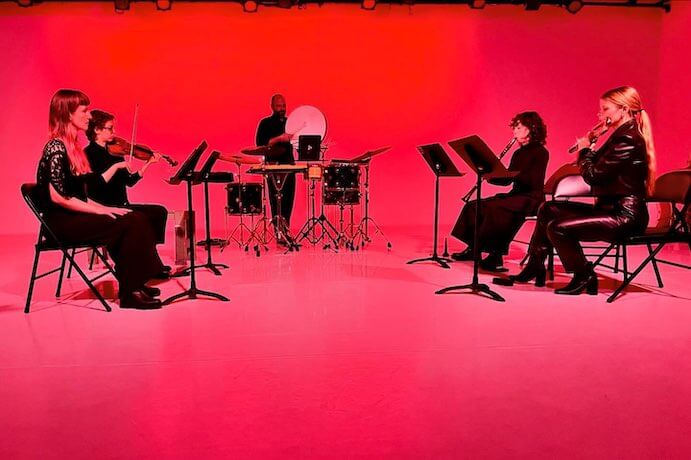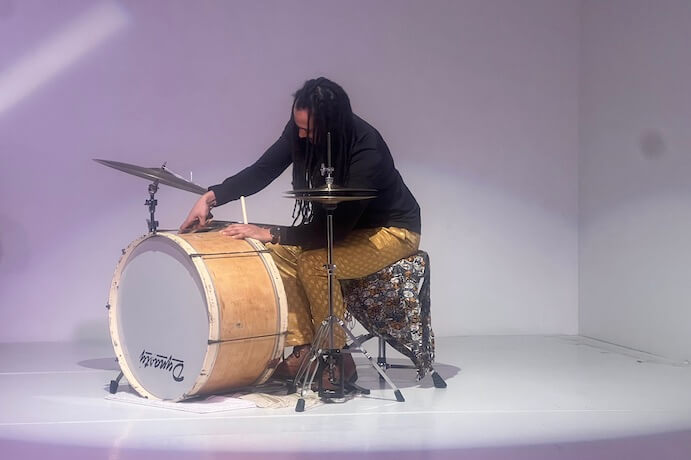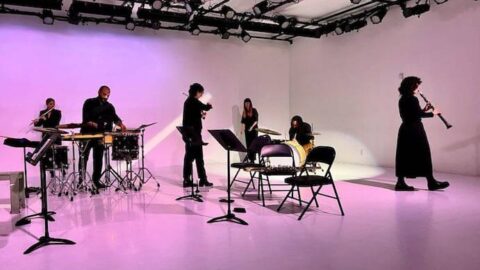Content warning: this review contains discussion of racial violence
The Center for Performance Research (CPR) was awash in peachy-pink lighting as TAK Ensemble’s violinist Marina Kifferstein warned us that the two pieces we were about to experience would get uncomfortably loud; there were earplugs in the lobby, but it was acceptable to plug your ears, if needed. I had trekked from the Bronx to Brooklyn for the dual world-premiere offering of ARTEFACTS and Censored Sounds: Structural Erasure on Mar. 2 expecting only a presentation of new compositions. But CPR and TAK had programmed an evening of multi-layered collaborations and musical discussions within the multi-purpose space, cultivating the “curiosity, change, and caring communication” that is integral to TAK’s mission, pushing forward during their tenth anniversary season.
ARTEFACTS is the ensemble’s first group composition, and Jessie Cox’s Censored Sounds: Structural Erasure marked the debut collaboration between the composer and the ensemble. Kifferstein’s excitement while introducing the program was infectious; in her words, Cox’s piece “needed no explanation,” though lamentably, this meant no printed or online program, which would have deepened the audience experience.
ARTEFACTS sought to reflect the group’s individualized creative work and their individual instrumental prowess. With the room still bathed in pink, the ensemble members stood in a semicircle formation. The piece began with ritualistic tapping of their bodies at specific acupuncture meridian points, executed stereophonically. Soprano Charlotte Mundy framed the piece with her narration about speaking, breathing, and stargazing. Between these brief spoken passages, we were coaxed into TAK’s ceremonial soundworld with breathy woodwinds and subtle, non-vibrato string bowings. The audience was fully immersed in their post-spectralist drone textures; high and prominent clarinet multiphonics, artfully and articulately performed by Madison Greenstone, were accompanied by flutist Laura Cocks, whose harmonic spectrum made my ears start to tingle.

I eventually realized that TAK Ensemble was turning the CPR into their own real-time Dream House, creating drones reminiscent of La Monte Young’s sine-tone structures and bathing the building in soft pink hues like Marian Zazeela’s light sculptures. The incisive and thick tones were balanced by juxtapositions of breathy woodwinds, whisper-thin bowings, and soft rumblings and growls of a rubber superball mallet running over the tom-toms and other membranophones in Ellery Trafford’s percussion setup. For a piece that had strong utterances and wailing tones, ARTEFACTS ended quietly with rustling gestures, including Cocks crumbling a dried-up plant onstage.
While ARTEFACTS was a coherent standalone work, it also served as a good prelude to the world premiere of Cox’s Censored Sounds: Structural Erasure, which shared similar repetitions of sounds and timbres and extreme intensity. As stated in the title, the piece is about Black erasure and lynching. There is no room for misinterpretation here. Cox interweaves his text, recited by Mundy, with mumbling bass flute accompaniment, which framed what we were hearing. Mundy read:
“It is a well-known fact that some of the photos that helped document the Holocaust were taken by Nazis. It is a well-known fact who lynched the Negroes. The Nazis tried to erase their own violence. Lynching happened both without record but also as mass spectacle with souvenirs. How many Black lives are taken by societal violence? The forgetting of George Floyd and Black Lives Matter is happening faster than time.”
The audience was compelled to listen and witness the overt sonification of the photographs mentioned in these monologues between movements. Cox’s work initially presented the most delicate textures from the violin, quietest breaths and trills from the woodwinds, and fluffiest mallets barely scraping the hand drum, which immediately translated into a quiet rage. But most of the work was overt rage through blatant fortissimo clarinet multiphonics that never dissipated, along with high piccolo, high screaming voice, and rapid-fire screechy violin; the clashing difference tones and death whistles were relentless. Everything was turned up to eleven. It was noisy. It was purposefully undesirable.

The piece then incorporated musical weeping and wailing with ritualistic movement, literally channeling their message to the four corners of the room. The composer joined the ceremony from the audience with a small talking drum, moving to stroking blows on the drumset in the corner before retreating to the audience once more.
These movements and rituals continued for 45 minutes. I liked the timbres created by the narration and bass flute combo, but I could not trace the text’s trajectory. Were these snippets of Cox’s scholarly work? Was the piece a musical response to his prose? Does this work articulate Cox and Isaac Jean-François’ concept of Black Breathing, or is it a pure sonification of fury?
Unfortunately, the lack of program notes and information took away valuable framing and context that would have strengthened the concert and served its contributions better. The desire for such information was less about resolution — arguably impossible given the subject — and more for instilling urgency in saving Black lives. That being said, given the high level of virtuosity needed to execute both pieces, only TAK Ensemble could successfully create and perform this program. As a first-time concert-goer, I was impressed.
I CARE IF YOU LISTEN is an editorially-independent program of the American Composers Forum, funded with generous donor and institutional support. Opinions expressed are solely those of the author and may not represent the views of ICIYL or ACF.
A gift to ACF helps support the work of ICIYL. For more on ACF, visit the “At ACF” section or composersforum.org.
























